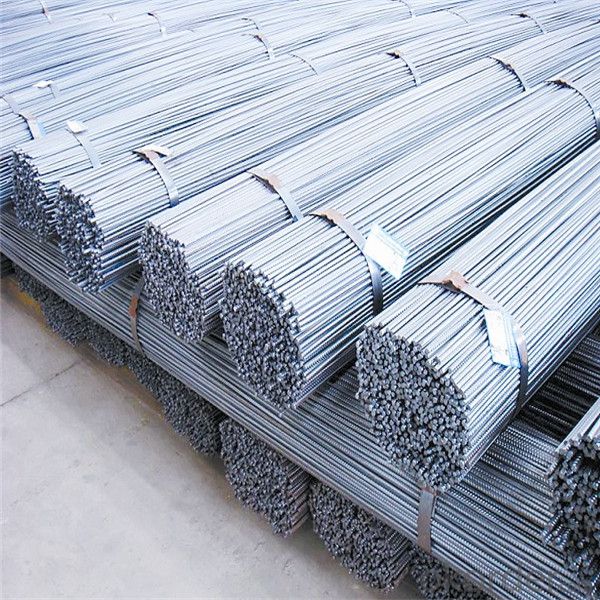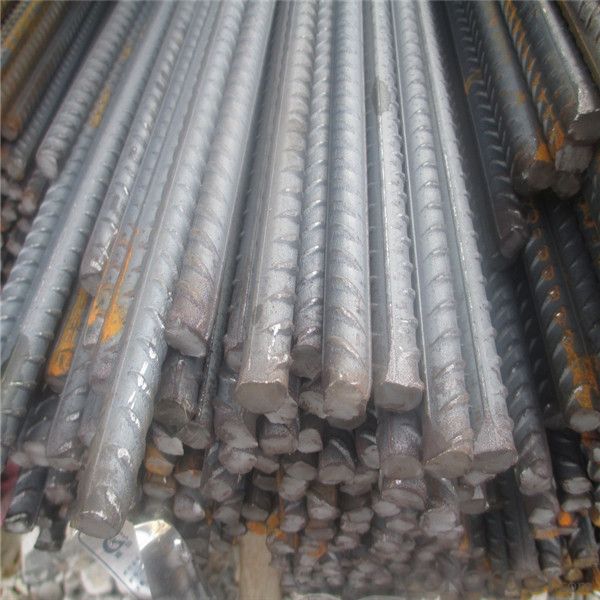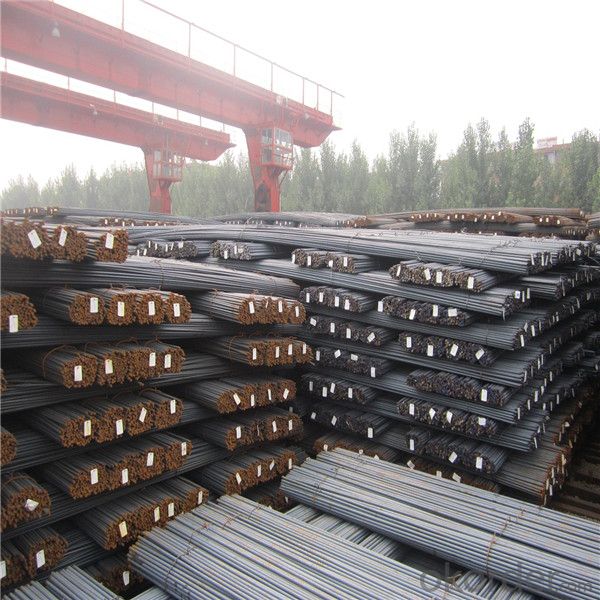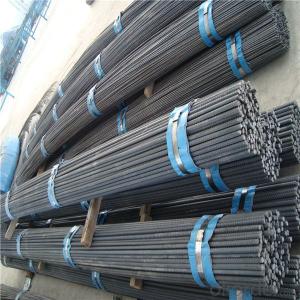Rebar steel for building construction different grade
- Loading Port:
- Tianjin
- Payment Terms:
- TT OR LC
- Min Order Qty:
- 500 m.t.
- Supply Capability:
- 17689 m.t./month
OKorder Service Pledge
OKorder Financial Service
You Might Also Like
Item specifice
Steel rebar is bars of steel commonly used in construction, especially for reinforcing concrete structures
such as driveways, foundations, walls, and columns.Most grades of steel used in rebar cannot accept welding;
such as, to adjacent steel plates or as means to bind single pieces of rebar together. However, special grades
of rebar steel and welding rods make welding by expert welders possible.
To prevent workers from accidentally impaling themselves, the protruding ends of steel rebar are often bent over
or covered with special plastic "mushroom" caps
Our Advantage:
High quality steel products from 1 class mills in China
Reasonable price
Professionalism of the products
On-time delivery
Complete documents and certificates
Sincere service to meet our clients' requirements
Product Description :
Chemical composition (%): | Steel | C | Si | Mn | P | S | Ceq | ||||
HRB335 |
0.25 |
0.80 |
1.60 |
0.045 |
0.045 | 0.52 | |||||
HRB400 | 0.54 | ||||||||||
HRB500 | 0.55 | ||||||||||
Mechanical properties | Steel | Rel/ MPa | Rm/ MPa | A/ % | Agt/ % | ||||||
≥ | |||||||||||
HRB335 | 335 | 455 | 17 |
7.5 | |||||||
HRB400 | 400 | 540 | 16 | ||||||||
HRB500 | 500 | 630 | 15 | ||||||||
Package: | Standard export packing or as customer's request | ||||||||||
Application: | Construction, building, bridge, road. ect | ||||||||||
Payment terms | 1).100% irrevocable L/C at sight. | ||||||||||
Delivery time | 15-30 days after receipt of L/C or deposit by T/T | ||||||||||
Features
1、Pure steel quality, stable chemical contents, small tolerance.
2、Constant Quality, good drawing performance.
3、High dimension accuracy degree, accuracy degree of Level C up to 80%, smooth surface, less scale, easy to be pickled.
4、Automatic bundling with 4 lines by Machine in tidy and good looks
5、Big high quality percentage, small coil percentage, and heavy coil weight for Hard Coil.
6、High sorbitizing percentage.


Packing:
In bundles, each bundle weight 3.5 tons. Load by container or by bulk verssel.


Our service
(1) We cooperate with famous factories with advanced equipment and well trained workers.
(2) We can provide factory price with trading company service.
(3) We continuously work on the improvement of our processes, guaranteeing consistently high standards
of quality to keep none compensation.
(4) We guarantee 24 hours response and 48 hours solution providing service.
(5) We accept small order quantity before formal cooperation.
(6) We deliver the agreed quality at the agreed time, reacting to changes in customer wishes in a flexible way.
(7) Due to our volume and selling power, we have excellent freight rates with shipping lines.
(8) We strive to always be fair and honest in our dealings with customers.
(9) We strive to work together with customers to achieve much more than we can achieve alone.
(10) Through our passion and commitment we aim to be a market leader in all our key markets. To maintain
our position as market leader we must continue to add value in all that we do.
FAQ:
1.Q: What's your MOQ(minimum order quantity)?
A: One full container, mixed acceptable .
2. Q: What's your packing methods?
A: Packed in bundle or bulk ..
3. Q: How can I buy CNBM products in my country?
A:Please send us an inquiry or email ,we will reply to you if there is distributor in your country
4. Q: Can we visit your factory?
A: Warmly welcome. Once we have your schedule, we will arrange the professional sales team to follow up your case.
5. Q: How long does it take to get the product if i place an order?
A:With the process of your requirements,we will pack and deliver in 3-7 days. If it is by sea shipment,it will take 15-45 days depending on different locations
- Q:What is the maximum length of steel rebars that can be manufactured?
- The maximum length of steel rebars that can be manufactured depends on various factors such as the manufacturing process, transportation limitations, and practical considerations. However, in general, steel rebars can be manufactured up to lengths of around 60 feet (18 meters).
- Q:How are steel rebars transported and stored on construction sites?
- Steel rebars are typically transported to construction sites using trucks or trailers. These vehicles are designed to safely carry and unload the heavy and bulky rebars. Upon arrival at the site, the rebars are usually offloaded using cranes or forklifts. To ensure efficient storage and easy access, rebars are often stored in designated areas called rebar yards. These yards are typically organized in a way that allows for easy identification and retrieval of rebars when needed. The rebars are sorted and stacked according to their size, length, and type to prevent any confusion during construction. In the rebar yard, rebars are commonly stored horizontally on steel or wooden racks. The racks are designed to provide proper support and prevent damage to the rebars. It is important to note that rebars should be stored above ground level to protect them from moisture, rust, and contamination. They should also be kept away from any damp areas or direct contact with soil. To maintain the quality of the rebars, it is crucial to protect them from exposure to rain, snow, and excessive sunlight. Therefore, construction sites often use protective covers, such as tarps or plastic sheets, to shield the rebars and prevent any corrosion or deterioration. Additionally, construction workers must handle rebars with care to avoid any bending or deformation. Special attention should be given to prevent rebars from being dropped or dragged, as it can compromise their structural integrity. Overall, the transportation and storage of steel rebars on construction sites require careful planning and adherence to safety guidelines to ensure their quality and effectiveness in reinforcing concrete structures.
- Q:Are steel rebars suitable for use in sports stadiums and arenas?
- Yes, steel rebars are commonly used in sports stadiums and arenas due to their strength, durability, and ability to withstand heavy loads, making them suitable for such structures.
- Q:How are steel rebars measured and priced?
- Steel rebars are typically measured and priced based on their length, thickness, and weight. The length is measured in feet or meters, and the thickness is measured in inches or millimeters. The weight is usually given in pounds or kilograms. The pricing of steel rebars depends on current market conditions, including factors such as supply and demand, raw material costs, and manufacturing expenses. Additionally, any additional processing or customization requested by the customer may also impact the final price.
- Q:How do steel rebars contribute to the overall aesthetics of a structure?
- Steel rebars do not necessarily contribute to the overall aesthetics of a structure as they are typically hidden within the concrete. However, they play a crucial role in reinforcing the concrete, ensuring structural integrity, and enhancing the durability and longevity of the building.
- Q:Can steel rebars be used in structures with high humidity levels?
- Indeed, structures with high humidity levels can utilize steel rebars. These rebars find widespread use in various construction projects, particularly in environments abundant in moisture such as coastal areas or buildings with high moisture content. Nevertheless, it is crucial to guarantee the safeguarding of steel rebars against corrosion to uphold their structural integrity. This can be accomplished by employing suitable coatings or selecting corrosion-resistant steel rebars, such as stainless steel or epoxy-coated rebars. Furthermore, regular maintenance and inspection are indispensable to avert any potential corrosion concerns and guarantee the structure's long-term durability.
- Q:What are the factors to consider while designing a reinforced concrete structure with steel rebars?
- Designing a reinforced concrete structure with steel rebars requires careful consideration of various factors to ensure its strength, durability, and safety. Here are some key factors to consider: 1. Structural Requirements: The first step is to determine the specific purpose of the structure and its load-bearing capacity. This includes considering the intended use, maximum load, and any potential dynamic loads such as wind or earthquakes. 2. Material Selection: Choosing the right type and grade of concrete and steel rebars is crucial. The concrete mix should have adequate strength, workability, and durability to withstand the anticipated conditions. Similarly, the rebars should have sufficient yield strength and corrosion resistance to maintain structural integrity over time. 3. Reinforcement Layout: The design should include an appropriate layout and spacing of rebars to distribute the load uniformly and prevent cracking or structural failure. This involves determining the rebar size, quantity, and arrangement based on the calculated forces and bending moments. 4. Concrete Cover: The concrete cover refers to the thickness of concrete surrounding the rebars. It is crucial to provide adequate cover to protect the rebars from corrosion, fire, and other environmental factors. The cover thickness should be determined based on the exposure conditions and the required durability. 5. Bonding between Concrete and Rebars: Proper bonding between the concrete and rebars is essential for transferring forces effectively. The design should consider factors such as mechanical interlocking, chemical adhesion, and surface treatment to ensure a strong bond and prevent slippage or separation. 6. Construction Considerations: The design should account for practical construction aspects such as formwork, placement, and compaction of concrete. It should also incorporate appropriate detailing for construction joints, lap splices, and anchorage of rebars to ensure proper installation and ease of construction. 7. Serviceability and Durability: The design should address serviceability requirements such as deflection limits, cracking control, and long-term performance. Additionally, it should consider factors that impact durability, such as exposure to moisture, chemicals, temperature variations, and potential for corrosion. 8. Quality Control and Inspection: Quality control measures, including testing of materials, monitoring during construction, and inspection of completed work, are crucial to ensure that the design requirements are met. Regular inspections and adherence to construction standards and codes are essential for the overall integrity and safety of the structure. By considering these factors and following appropriate design codes and standards, a reinforced concrete structure with steel rebars can be designed to provide the desired strength, durability, and safety throughout its lifespan.
- Q:Can steel rebars be used in earthquake-prone regions?
- Yes, steel rebars can be used in earthquake-prone regions. Steel rebars are commonly used in the construction of reinforced concrete structures to enhance their strength and provide resistance against seismic forces. The flexibility and ductility of steel make it an ideal material for earthquake-resistant construction. Properly designed and installed steel rebars can improve the structural integrity and overall performance of buildings in earthquake-prone areas.
- Q:Can steel rebars be used in structures with high resistance to fire?
- Yes, steel rebars can be used in structures with high resistance to fire. Steel has a high melting point and excellent fire resistance properties, making it a suitable choice for reinforcing structures that need to withstand high temperatures and fire hazards.
- Q:What is the recommended spacing between horizontal steel rebars in beams?
- The recommended spacing between horizontal steel rebars in beams varies depending on several factors such as the design requirements, load conditions, and specific building codes. However, a common guideline is to maintain a minimum spacing of three times the diameter of the rebar or three times the thickness of the beam, whichever is greater. It is important to consult with a structural engineer or refer to local building codes for specific recommendations to ensure the structural integrity of the beams.
1. Manufacturer Overview |
|
|---|---|
| Location | |
| Year Established | |
| Annual Output Value | |
| Main Markets | |
| Company Certifications | |
2. Manufacturer Certificates |
|
|---|---|
| a) Certification Name | |
| Range | |
| Reference | |
| Validity Period | |
3. Manufacturer Capability |
|
|---|---|
| a)Trade Capacity | |
| Nearest Port | |
| Export Percentage | |
| No.of Employees in Trade Department | |
| Language Spoken: | |
| b)Factory Information | |
| Factory Size: | |
| No. of Production Lines | |
| Contract Manufacturing | |
| Product Price Range | |
Send your message to us
Rebar steel for building construction different grade
- Loading Port:
- Tianjin
- Payment Terms:
- TT OR LC
- Min Order Qty:
- 500 m.t.
- Supply Capability:
- 17689 m.t./month
OKorder Service Pledge
OKorder Financial Service
Similar products
New products
Hot products
Related keywords




























